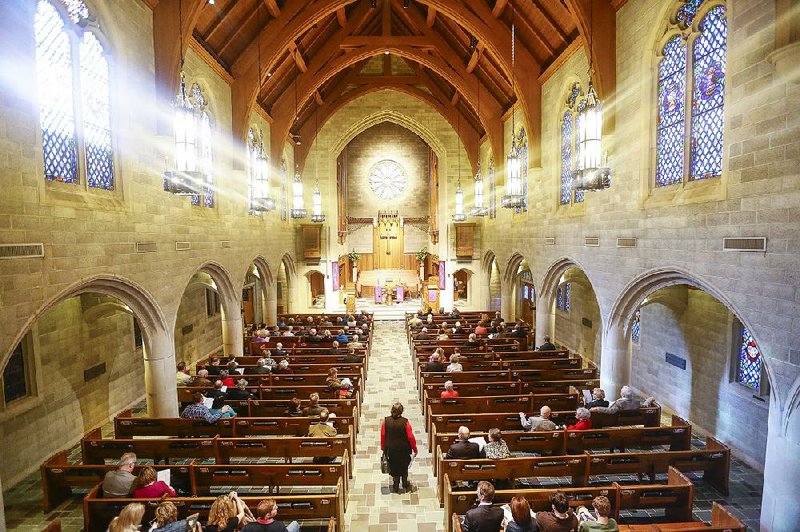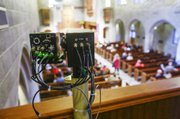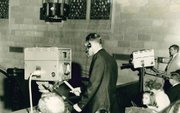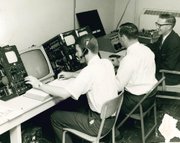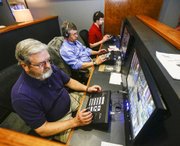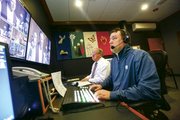Sunday after Sunday since 1966, television viewers in much of the state have been able to worship along with the congregation of Pulaski Heights United Methodist Church. The congregation will celebrate that milestone on Sunday, 50 years to the day since the first broadcast.
A lot has changed since the church's Broadcast Ministry started with a small team operating two secondhand black-and-white cameras bought from a Dallas TV station.
"The equipment was very crude," said Ray Schaap, who serves as the broadcast producer.
These days, the crew orchestrates the broadcast from a high-tech control room, which was built last year. Six remote-control, high-definition digital cameras are placed around the sanctuary to capture various angles during services, while the team works remotely from a control room filled with flat-screen monitors.
Schaap has been involved with the Broadcast Ministry since 1978, and his wife, Lavern, soon got in on it, too. He said the goal has always been the same -- "to get the word of God to the people of Arkansas through television."
The TV ministry was the idea of the Rev. James B. Argue, the senior pastor at the time.
Judy Goss, who serves as director, said Argue thought a television ministry would serve Methodism well as a way to spread the faith.
"Thirty folks donated seed money to begin it," she said.
With the funds and the used cameras, the original crew put together the first broadcast on March 6, 1966, sending the signal to a television studio downtown. The size of the audience for that first broadcast isn't known, but today the Sunday service is seen by more than 12,000 viewers. Thousands more watch the service via YouTube.
The ministry team of 18 includes eight working on Sunday mornings -- three on camera operation, one on audio, one on character or graphics generation, one on the technical aspects, plus a director and a producer. All but one in the ministry are volunteers.
Each Sunday morning starts the same way for Schaap. He arrives around 7:30 and takes a look at the day's bulletin, scanning the order of worship so he'll know what's happening and can think about how to best convey the service to viewers.
"I line it out so the director can follow along and I can help," Schaap said.
The team records the 9 a.m. service in the sanctuary and sends it for broadcast on KATV, Channel 7, at 10:30 a.m. each Sunday.
Goss said Schaap is known as "the captain" and he's always ready to go.
"I don't think people understand how well he's prepared," she said.
That attention to detail is important because there's no time for editing out mistakes before the broadcast. What's filmed at the 9 a.m. service is exactly what viewers see when the broadcast hits the airwaves at 10:30.
The Rev. Britt Skarda, the church's senior pastor, said he's comfortable in front of the cameras but there was a time he felt the pressures of "live" TV. It was when he was serving as an associate pastor at the church in the late 1980s and early '90s. One Sunday when he was slated to preach he was told the broadcast and live service for the day would have to be cut to 30 minutes, so that was the amount of time he was expecting to fill.
"So I'm standing in the pulpit preaching and this hand comes up beside me and places a note that says, 'We're on for an hour. Stretch it out,'" he said.
He stretched.
There have been some bloopers through the years, but most of the memorable ones happened while filming weddings. A groom fainted during one. In another, balloons were released, floating high enough to block the camera -- and consequently the bride and groom -- from view.
The team members feel the pressure to get things right, but the camaraderie among them eases the process.
"To me it's family," Lavern Schaap said.
And for the Schaaps it's also a family affair. Their two sons were interested in the ministry early on, got involved and went on to enter careers in broadcast journalism because of what they learned at the church.
"It's such a fun thing to do," said Goss, who got her start in the ministry operating a camera in the balcony. "It's something very important to us -- to present our faith and the message of God from the Methodist tradition out to the state. It isn't just a hobby. We take it seriously and I try to do it well."
Team member Ray White said the church receives letters and email from viewers from all over. Some are shut-ins who watch because they can no longer attend services at the church or at their own churches. Others tune in while traveling or while sick at home. Some wouldn't dream of stepping foot inside a church and find it easier to watch the services on TV.
White said one couple reported that they would eat breakfast, get dressed in their Sunday clothes and then sit down to watch the service.
"They felt like they were in church with us," he said.
Lavern Schaap said her terminally ill aunt found comfort in the broadcast.
"For her, church was our church on TV," she said.
Dot Morey of Little Rock watches the service each Sunday at her retirement community. The 86-year-old attends Sunday School with other residents and then comes back to her room for church. She finds it meaningful.
"The message, the music and the weekly events keep us in touch at Pulaski Heights United Methodist through the years, especially the homebound," she said.
The television broadcast has also enticed some to attend the church in person and become members. That was true for Goss and her husband.
"We watched it and were so impressed. It led us to join," she said.
The congregation is also a part of the ministry. They are the face of the church that viewers see.
"We try to represent the church, and that means the congregation is a big part of the broadcast, and I think they know that and are proud of it," White said.
In the days before the church had six cameras that cover virtually the entire sanctuary, some camera-shy worshippers would scout out the best place to sit to avoid being on TV. These days that's almost impossible. But those who don't want to appear on camera can attend concurrent services in another room.
Skarda, who is on camera often, said the broadcast is an important ministry for the church.
"I like to think perhaps that at Pulaski Heights United Methodist our expression of the Christian faith is authentic and in a day when people are questioning the authenticity and sincerity of the faith, we offer a healthy alternative to that. You can hear worship, beautiful music and experience the sacraments and really see what happens in a worship service, and through that hear about our missions and ministry and what we are doing in the community and around the world."
Skarda said the TV service offers viewers the ability to "stand on the threshold" and have a peek inside before deciding to come in person.
"I'm constantly told by people, 'When I cannot make it to my church I watch you on Sunday morning,' which is really nice," Skarda said. "We like them to have their own church home, but it's nice to fill in when they can't make it. Based on the letters and emails and calls and Facebook messages, people of every persuasion watch us -- the religious, nonreligious, Methodists, Roman Catholics -- a broad spectrum of folks."
Knowing there's such a wide audience also plays into his sermon writing.
"I realize that I'm speaking beyond my own congregation, beyond my own denomination and my own city to something much bigger," he said. "I try to speak a language people understand, not just religious language or Methodist language but language people beyond the church can hear."
In celebration of the 50th anniversary, members of the Broadcast Ministry will greet worshippers as they arrive for the 9 and 11 a.m. services on Sunday and offer snacks and information about the history of the ministry, including showing a video. A reception will be held downstairs, and the control room will be open to visitors between 10 and 11 a.m.
The church is at 4823 Woodlawn Drive. Information is available online at phumc.com.
Religion on 03/05/2016
